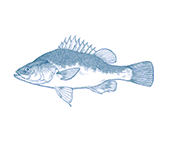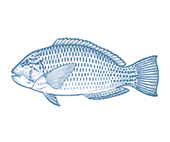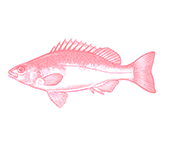




- Eat Less
Wild Caught
Region:
Commonwealth waters
- Deepwater flathead are caught in the Commonwealth SESSF Great Australian Bight Trawl Sector using bottom trawl fishing methods. The catch comes from the outer continental shelf and upper slope waters offshore of SA and southern WA.
- Deepwater flathead populations appear healthy, but there are some concerns arising from declining catches in independent fishing surveys.
- The fishery catches some threatened species such as Australian fur seals, shortfin mako sharks and seabirds, although industry has been proactive in trying to reduce mortalities of these vulnerable species.
- The fishery discards 40-60% of the catch by weight (unwanted marine animals that are caught and thrown back overboard), with little understanding of the ecological impacts or on the stock status of discarded species.
- The fishery operates around a major global ocean heating hotspot but does not explicitly account for climate change when setting future catch limits. Significant research in this area is welcome, but is overdue.
- Significant research has been undertaken into the ecosystem impacts of the fishery, and marine park protections are in place in some areas of the fishery that provide an additional degree of resilience for target and bycatch species, and vulnerable seafloor habitats.
- The fishery is expected to undergo its second round of major reforms, and implement vital camera monitoring across the fleet in coming years. This has the potential to significantly improve the GoodFish ranking of this fishery in future.
- Commonwealth Southern and Eastern Scalefish and Shark Fishery (Great Australian Bight Trawl Sector) (701t in 2021/22).
Deepwater flathead is an endemic benthic predatory fish found on sandy and muddy habitats in outer continental shelf and upper-slope waters from South Australia to southern WA, in depths to 500m.
They are caught using bottom trawl fishing methods in the Commonwealth-managed Southern and Eastern Scalefish and Shark Fishery (SESSF) Great Australian Bight Trawl Sector. The SESSF is Australia’s largest source of locally caught finfish for the domestic market.
While stock assessments suggest that deepwater flathead populations are healthy, there is some concern from significantly declining catches in a fishery independent survey that warrant more careful management in future and are potential indicators of overfishing.
The fishery has made significant progress in reducing protected seabird bycatch, though fur seal bycatch is potentially increasing. Seal Excluder Devices (SEDs), which act as escape hatches for seals that enter trawl nets, are mandatory. All trawl boats must have a seabird management plan in place to guide how each boat aims to reduce interactions with seabirds while actively fishing. Many of the solutions to seabird interactions have been fishing industry-led innovations and are proving highly successful in reducing these impacts.
The SESSF operates around a global ocean heating hotspot, warming at almost four times the global average. While serious climate impacts have been attributed to declining SESSF fish stocks for around a decade, there is still no explicit consideration of climate impacts when setting future catch limits. Significant research is underway in this area, which is welcome but overdue.
Some of the area where fishing occurs has been well mapped in order to identify the distribution of sensitive bottom-dwelling species. Trawling sometimes takes place on areas of seafloor that support sponges, hard corals and bryozoans (small invertebrates that form colonies similar to coral reefs), but it is unclear how much trawling activity is resulting in damage to habitats and associated species. Some areas of marine habitat are protected in marine parks and through other spatial closures. It is likely the fishery has had a high impact on the marine environment in the past, and spatial closures and reductions in the amount of fishing over the past two decades has reduced that impact.
Independent monitoring of the part of the SESSF that catches deepwater flathead has been insufficient to ensure robust information is collected on protected species bycatch and fish discarding, which can occur when fish are caught in trawl nets that the fisher holds no quota for, so cannot land without financial penalty. This creates significant risk as it impedes managers in reliably calculating the total impact (of all fishery mortality from retained plus the fish caught but thrown back) on fish stocks from the fishery.
There are concerns about the high volume of discarded, unwanted fish, though there is no evidence that this is causing declines of other species, it cannot be discounted. ‘Discards’ can account for 40-60% of the total catch weight, and are generally thrown overboard. There is some evidence that the catch composition of the fishery is changing, which may indicate that there is an ecosystem change in the fishery which may be in part caused by fishing impacts.
The fishery is set to introduce video monitoring across the fleet in 2024 which is welcome and could substantially address this issue, but it is notable that improving this information collection was also a condition of a fishery reform process in 2006 that was not followed through.


